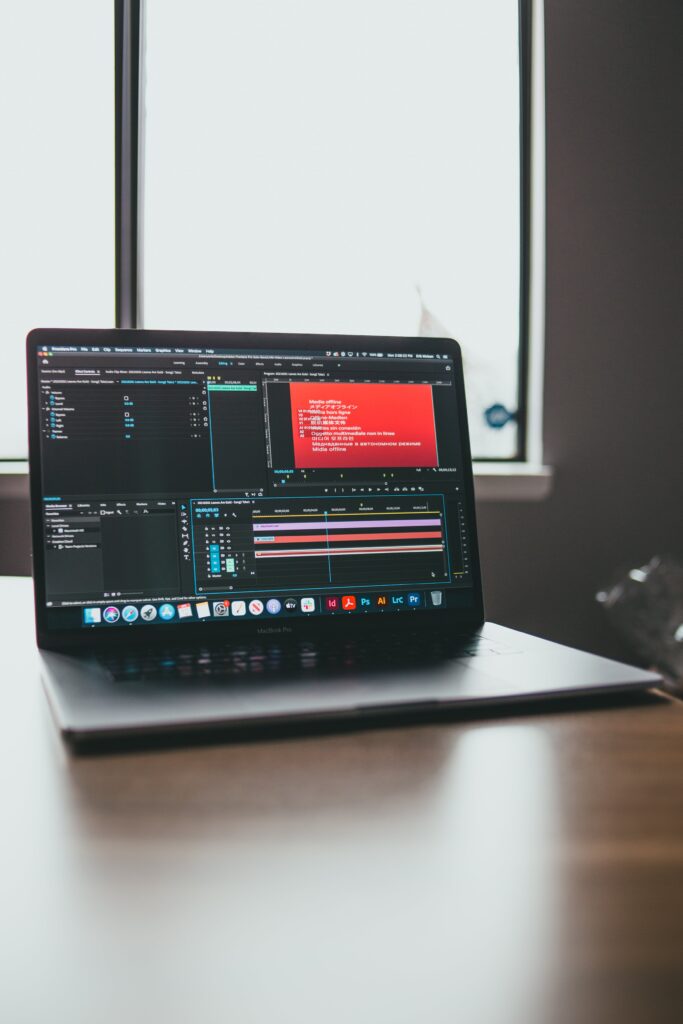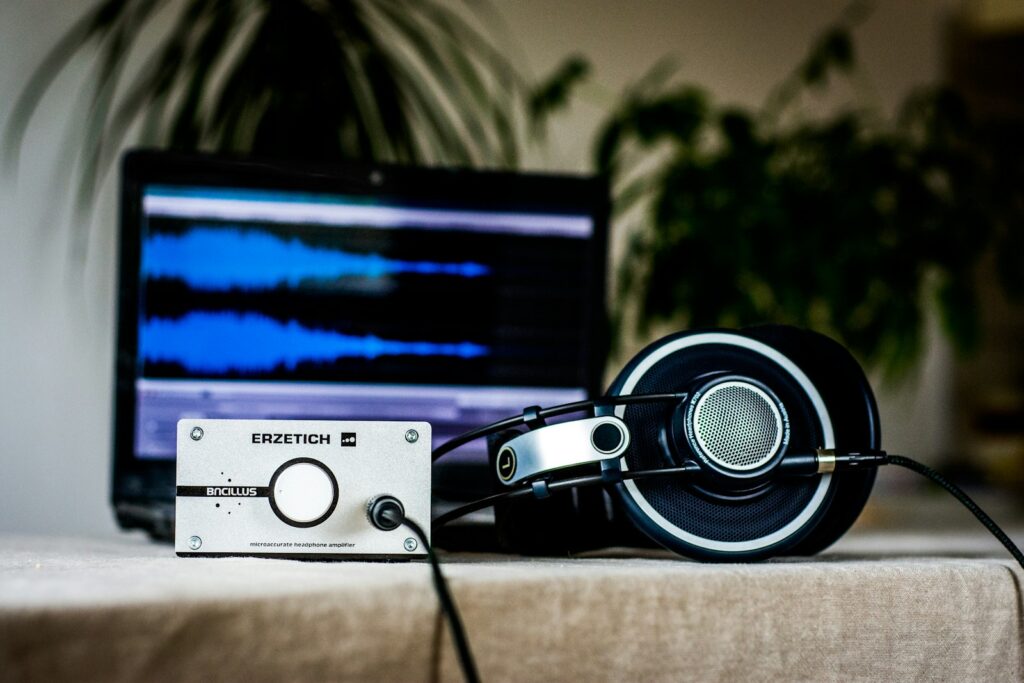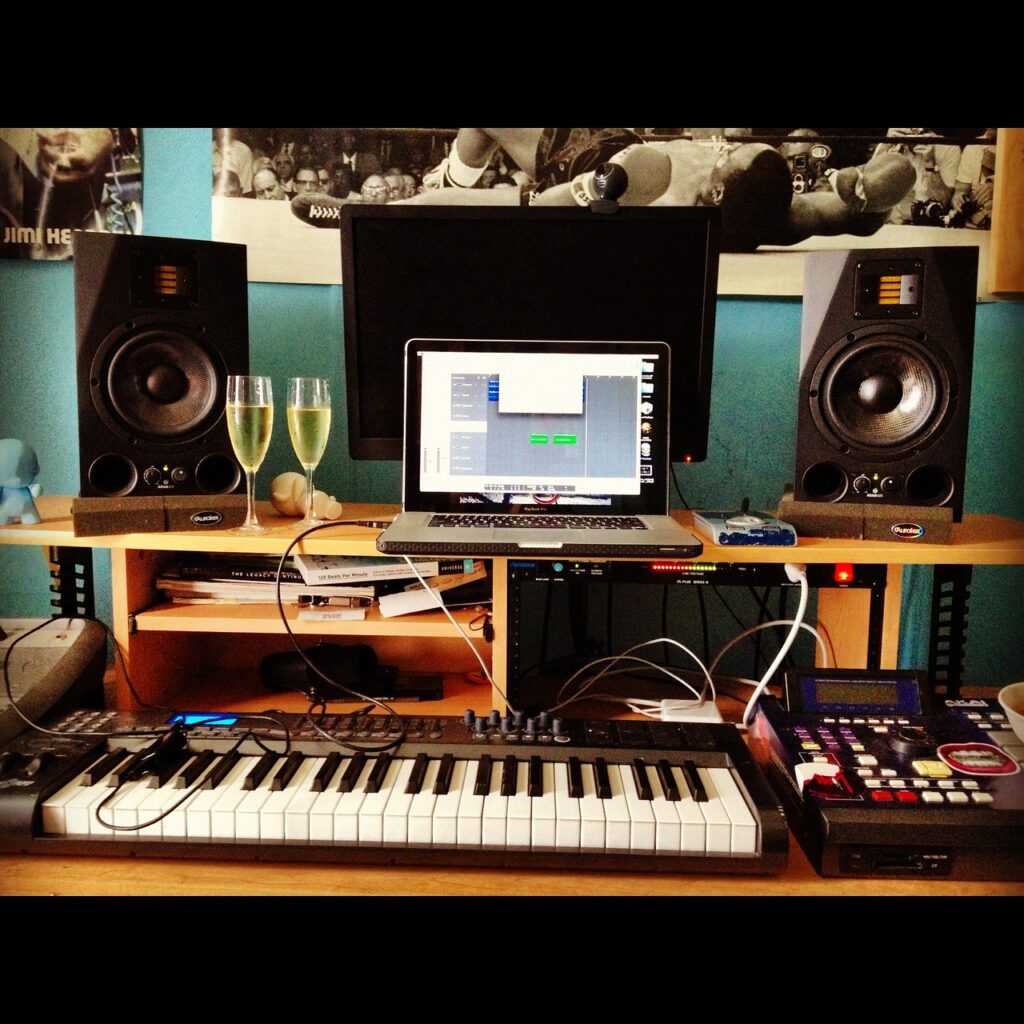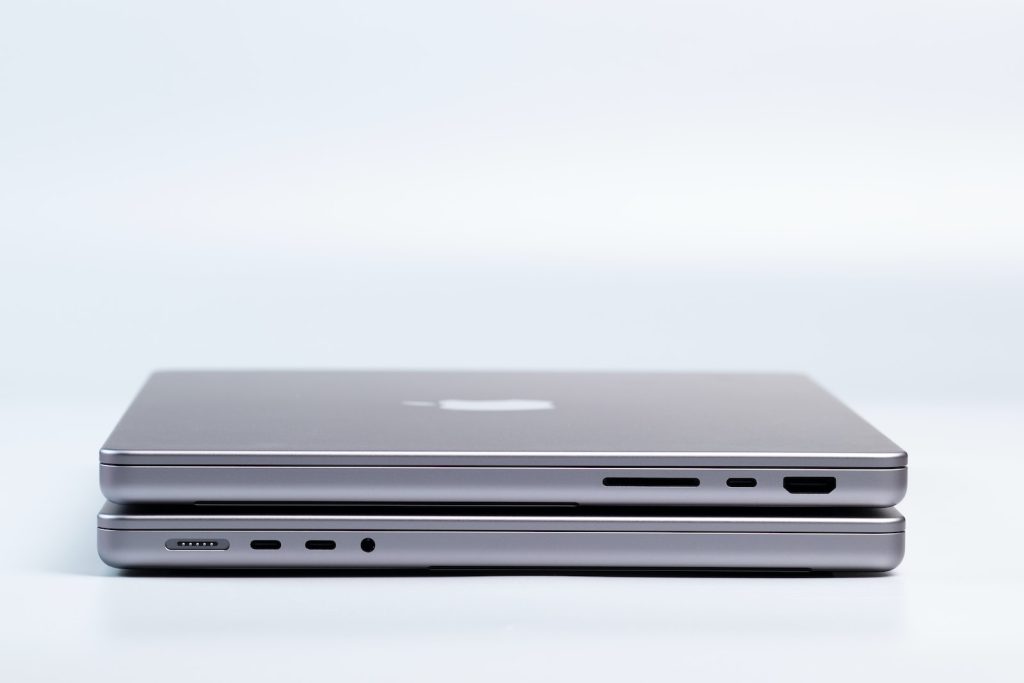This website may contain affiliate links, which means I may receive a commission if you click on a link and make a purchase. While clicking on these links won't cost you any extra money, they will help me keep this site up and running. Your support is appreciated!

Hey there music makers and laptop lovers! Are you ready to turn your ordinary laptop into a mind-blowing music production machine?
Well, guess what? Today we’re diving deep into the world of the best music production software for laptops. Whether you’re a beginner beat maker or a seasoned producer, having the right software can make all the difference. And lucky for you, we’ve scoured the internet and found the cream of the crop.
So grab your headphones, plug in, and get ready to unleash your musical genius with this list of the best music production software available.
Need help choosing the perfect laptop to run these software? Check out goodlaptops.com for some awesome recommendations. Let’s dive in!
Table of Contents
- Unleash Your Creativity with Ableton Live
- Get Professional Results with Logic Pro X
- Explore Limitless Possibilities with FL Studio
- Make Beats and Tracks like a Pro with Pro Tools
- Create Unique Soundscapes with Native Instruments Maschine
- Produce High-Quality EDM with Propellerhead Reason
- Dive into Electronic Music Production with Bitwig Studio
- Experience Seamless Workflow with Steinberg Cubase
- Uncover New Sonic Territories with Presonus Studio One
- Ready to Unleash Your Musical Creativity? Let’s Dive into Studio One!
- The Lowdown on Studio One
- Step-by-Step Guide to Getting Started
- Essential Studio One Shortcuts
- Studio One: Your Ultimate Sound Design Playground!
- Breaking Down Studio One’s Sound Design Tools
- Tips for Mind-Blowing Sound Design
- Collaboration Made Easy: Studio One’s Team Player Mentality
- Studio One’s Collaboration Features at a Glance
- Step-By-Step Guide to Collaborating in Studio One
- Enhance Your Mixing Skills with Cakewalk Sonar
- Questions and Answers for Best Music Production Software for Laptops
Unleash Your Creativity with Ableton Live
What Makes Ableton Live One of the Best Music Production Software?
Are you tired of using music production software that limits your creativity? Look no further than Ableton Live! With its intuitive interface and powerful features, it’s no wonder why it’s considered one of the best music production software out there, especially for beginners. Let’s explore what sets Ableton Live apart:
- Flexible Workflow: Ableton Live offers a unique session and arrangement view, allowing you to experiment with different musical ideas seamlessly. Its non-linear approach lets you quickly switch between creating loops and arranging a full track, giving you the freedom to let your creative juices flow.
- Vast Sound Library: Don’t know where to start? Ableton Live provides a vast library of instruments, effects, and samples to jumpstart your creativity. From synths to drums to vocal samples, you’ll find everything you need to create your own unique sound.
- Real-Time Performance: Whether you’re a DJ or a live performer, Ableton Live’s real-time performance capabilities will elevate your show to the next level. Triggering loops, samples, and effects on the fly has never been easier, allowing you to captivate your audience with an immersive and dynamic performance.
- Extensive MIDI Capabilities: If you’re a fan of MIDI controllers, Ableton Live integrates seamlessly with a wide range of hardware, giving you tactile control over your music production. From drum pads to keyboards, your music-making experience will become more hands-on and enjoyable.
- Collaboration Made Easy: Collaborating with fellow musicians has never been simpler with Ableton Live’s easy-to-use collaboration features. Share your work in progress, collaborate on projects, and receive feedback from your peers, all within the software itself.
What are you waiting for? Take your music production to new heights with Ableton Live!
Step-by-Step Guide: Getting Started with Ableton Live
- Installation: Head over to Ableton’s website and download the software. Once downloaded, run the installer and follow the on-screen instructions. It’s a breeze!
- Launch the Software: After installation, launch Ableton Live and take a moment to familiarize yourself with the interface. Don’t worry, it may look a bit daunting at first, but you’ll get the hang of it soon enough.
- Create a New Project: To start a new project, click on “File” and select “New Live Set.” You can also use the shortcut “Ctrl + N” (or “Command + N” for Mac users). Voila! A blank canvas awaits your creative genius.
- Add Instruments: To add instruments to your project, click on the “Categories” tab in the browser view on the left side of the screen. Browse through the instrument library, select the one that catches your fancy, and drag it onto a MIDI track. Let the melodies begin!
- Record or Import Audio: Ready to lay down some vocals or add your own samples? Click on the “Audio” tab in the browser view and either record directly into Ableton Live or import your pre-recorded audio files. The possibilities are endless!
Remember, this is just a brief guide to get you started. Ableton Live has a wealth of features waiting to be explored, so don’t hesitate to experiment and let your creativity run wild!
Start your Ableton Live journey today!
Make Beats Like a Pro with Ableton Live
Have you ever wondered how your favorite producers create those infectious beats? With Ableton Live, you can join their ranks and make beats like a pro. Here’s a breakdown of the steps involved:
- Drum Rack Creation: Create a new MIDI track and drag in Ableton Live’s Drum Rack instrument. This versatile tool allows you to load different drum samples onto different pads, giving you full control over your drum sounds.
- Choose Your Sounds: Browse through Ableton Live’s vast sound library or load your own drum samples. Explore different genres and experiment with unique combinations to find your signature sound.
- Programming Beats: Double-click on a pad in the Drum Rack to open the Piano Roll editor. Here, you can draw in your drum patterns using the step sequencer or play them in using a MIDI controller. Don’t be afraid to get creative with your rhythms!
- Layering and Effects: Enhance your beats by layering different drum sounds and applying effects. Ableton Live offers a wide range of effects plugins such as reverb, delay, and compression, allowing you to shape your drum sounds to perfection.
- Arrangement and Automation: Once you’re satisfied with your beats, it’s time to arrange them into a full track. Use Ableton Live’s arrangement view to piece together your different sections and create an engaging music journey. Experiment with automation to add movement and dynamics to your beats.
Now go forth and become a beat-making master with Ableton Live!
Unleash your beat-making skills with Ableton Live!
Remember, these are just a few ideas to get you started on your Ableton Live journey. Get creative, dive deep into the software, and let your musical imagination run wild.
Get Professional Results with Logic Pro X

Are you ready to take your music production game to the next level? Look no further than Logic Pro X, one of the best music production software on the market for Mac Laptops. With its extensive features and user-friendly interface, Logic Pro X is the go-to tool for both aspiring and professional music producers. We’ll explore how you can utilize Logic Pro X to achieve professional results in your music production journey. Let’s dive in!
Creating a Killer Beat
Step 1: Start by opening up Logic Pro X and selecting a new project. You’ll be greeted with a blank canvas, ready for your creative genius.
Step 2: Choose your drum kit from Logic Pro X’s vast library of high-quality sounds. From classic kits to experimental percussion, there’s something for every genre.
Step 3: Utilize Logic Pro X’s powerful drum sequencer to program your beats. Experiment with different patterns, adjust velocities, and add fills to give your beats that extra flair.
Step 4: Take advantage of Logic Pro X’s built-in sampler and explore its extensive sound library. Add unique textures and layer your drums with instruments like claps, tambourines, or even offbeat cowbells!
Step 5: Mix and polish your beat by adjusting volume levels, panning instruments, and adding effects like reverb or compression. Logic Pro X’s flexible mixing console gives you full control over your sound.
Crafting Mesmerizing Melodies
Step 1: Start a new software instrument track in Logic Pro X. Choose from an array of virtual instruments such as pianos, synthesizers, or orchestral ensembles.
Step 2: Experiment with Logic Pro X’s Smart Controls to instantly shape the sound of your chosen instrument. Tweak parameters like attack, release, or resonance to create your desired tone.
Step 3: Take advantage of Logic Pro X’s MIDI editor to compose melodies, harmonies, or intricate musical arrangements. Utilize the piano roll, score, or drum grid view to unleash your creativity.
Step 4: Implement Logic Pro X’s library of virtual guitar amps and effects to add layers of depth and character to your melodies. From crunchy distortion to smooth delays, you’ll find everything you need to make your melodies stand out.
Step 5: Once you’re satisfied with your composition, fine-tune the mix by adjusting individual instrument levels, applying equalization, or adding automation controls. Logic Pro X empowers you to create a polished and dynamic final product.
Recording Stellar Vocals
Step 1: Set up your microphone and audio interface with Logic Pro X. Ensure your levels are optimal and tweak any necessary preamp settings for crystal-clear recordings.
Step 2: Create a new audio track and select the appropriate microphone input. Logic Pro X allows you to monitor your vocals in real-time, ensuring a seamless recording experience.
Step 3: Take advantage of Logic Pro X’s powerful vocal editing tools. Correct pitch, add harmonies, or experiment with creative vocal effects such as auto-tune or vocoder.
Step 4: Use Logic Pro X’s comping feature to piece together the best parts of multiple takes into one seamless vocal track. Tidy up any breaths or unwanted noises for a professional result.
Step 5: Enhance your vocal track with Logic Pro X’s comprehensive library of audio plugins. Add warmth with compressors, add space with reverbs, or create unique textures with creative effects.
By following these step-by-step guides, you’ll be well on your way to achieving professional results with Logic Pro X. Whether you’re a beginner or a seasoned producer, Logic Pro X provides all the tools you need to bring your creativity to life.
Explore Logic Pro X’s website to learn more about their features and download a trial version today.
Explore Limitless Possibilities with FL Studio
Why FL Studio Is the Best Music Production Software
When it comes to creating music, you want the best tools at your disposal. That’s where FL Studio comes in. Why is it considered one of the best music production software? Let’s take a closer look:
- User-Friendly Interface: FL Studio has a sleek and intuitive interface that makes it easy for both beginners and professionals to navigate. You don’t have to spend hours learning complex software – FL Studio gets you creating music right away!
- Versatility: Whether you’re into electronic, hip-hop, pop, or any other genre, FL Studio caters to all types of music production. With a wide range of virtual instruments, effects, and samples, the possibilities are truly limitless.
- Powerful Mixing and Mastering Tools: FL Studio offers a comprehensive set of tools for mixing and mastering your tracks. From advanced equalizers to multi-band compressors, you have everything you need to achieve that professional sound.
- Lifetime Free Updates: FL Studio values its users and provides lifetime free updates. You won’t have to spend extra money to keep up with the latest features and improvements – FL Studio has your back!
Getting Started with FL Studio – A Step-by-Step Guide
Now that you know why FL Studio is the best music production software, let’s dive into how you can get started:
- Installation: Visit the official FL Studio website and download the software. Follow the installation instructions, and you’ll be up and running in no time.
- Choose Your Workspace: FL Studio offers different layout options to suit your workflow. Experiment with the various layouts and choose the one that feels most comfortable for you.
- Import Audio: To start creating music, you can import audio files or record your own sounds directly into FL Studio. Simply drag and drop your files into the playlist or use the built-in recording feature.
- Compose and Arrange: FL Studio’s step sequencer makes it easy to create patterns and melodies. Use the piano roll to compose your music, and arrange your patterns in the playlist to create a full track.
- Mix and Master: Once you’ve arranged your track, it’s time to bring it to life with mixing and mastering. Use the mixer window to adjust levels, add effects, and fine-tune your sound.
- Export Your Track: When you’re satisfied with your music, export it as a high-quality audio file. FL Studio supports various formats, ensuring compatibility with other software and platforms.
Unleash Your Creativity with FL Studio – Tips and Tricks
Ready to take your music production skills to the next level? Here are some tips and tricks to help you unleash your creativity with FL Studio:
- Experiment with Effects: FL Studio offers a wide range of effects, from reverbs and delays to distortion and modulation. Don’t be afraid to explore different effects and see how they transform your sound.
- Use Automation: Automation allows you to add movement and dynamics to your music. Experiment with automating parameters such as volume, panning, and plugin settings to create interesting and evolving soundscapes.
- Explore Third-Party Plugins: While FL Studio already comes with a vast library of virtual instruments and effects, don’t limit yourself! Explore third-party plugins and expand your sonic palette.
- Collaborate with Other Artists: FL Studio makes it easy to collaborate with other musicians. Use the “Export MIDI File” function to share your project files, or try using the FL Studio collaboration feature to work on projects together in real-time.
- Learn Keyboard Shortcuts: Keyboard shortcuts can significantly speed up your workflow. Take the time to learn the most commonly used shortcuts in FL Studio, and you’ll find yourself working more efficiently.
FL Studio is a great music production software that opens up a world of possibilities for musicians and producers. With its user-friendly interface, versatile features, and powerful tools, you’ll have everything you need to create professional-level music.
Make Beats and Tracks like a Pro with Pro Tools

This software is one of the holy grail for professional music producers, and with a little guidance, you’ll be making beats and tracks like a pro in no time.
Getting Started with Pro Tools: Familiarize Yourself with the Interface
Alright, let’s fire up Pro Tools and get to know the interface. Don’t worry if it looks a bit overwhelming at first – we’ve all been there. Familiarizing yourself with the layout and tools is a crucial step towards unleashing your inner music-making genius.
Here’s a brief layout of the Pro Tools interface to get you started:
| Section | Description |
|---|---|
| Mix Window | Control your audio levels, effects, and more |
| Edit Window | Fine-tune your tracks and arrange them |
| Transport | Play, pause, record, and navigate your session |
| Toolbars | Access various tools and functions |
Take your time to explore each section, click around, and play with the different features. Soon enough, you’ll feel like a kid in a candy store, ready to bring your musical ideas to life!
Let’s Make Some Beats
Now that you’re familiar with the interface, let’s dive deeper into the wonderful world of beat-making with Pro Tools. Strap on your headphones, adjust your seat, and let’s get this groove started!
Step 1: Create a New Session
- Open Pro Tools and select “New Session” from the File menu.
- Name your session and choose a location to save it.
Step 2: Choose the Right Tempo
- Think about the vibe you want to create and set the tempo accordingly.
- Click on the “Tap Tempo” button to manually set the tempo if needed.
Step 3: Lay Down the Foundation
- Start by creating a new MIDI track in the Edit Window.
- Use Pro Tools’ built-in drum machine or import your own drum samples.
- Add a kick drum, snare, hi-hat, and any other elements you desire.
Step 4: Get Rhythmically Creative
- Experiment with different drum patterns and fills.
- Play around with beat subdivisions and accents to create interesting rhythms.
Step 5: Add Some Flavor
- Layer your drum sounds to add depth and texture.
- Experiment with effects like reverb and delay to give your beats a unique touch.
Remember, making beats is all about feeling the rhythm and letting your creativity flow. So don’t be afraid to break the rules and create something entirely unique!
Crafting Melodies and Tracks
Now that you’ve mastered the art of beat-making, it’s time to craft melodies and build full tracks that will take your music to the next level. Buckle up, because this is where the magic happens!
Step 1: Create a New Instrument Track
- In the Edit Window, create a new instrument track.
- Choose your desired virtual instrument and load it up.
Step 2: Lay Down Your Melody
- Grab your MIDI controller or use the piano roll editor to create melodies.
- Experiment with different scales, chords, and arpeggios to find the perfect sound.
Step 3: Explore Harmonies and Counter-Melodies
- Duplicate your melody track and create harmonies or counter-melodies.
- Play around with different intervals and voicings to add depth.
Step 4: Arrange Your Tracks
- Use the Edit Window to arrange your beats, melodies, and harmonies.
- Experiment with structuring your track, adding breaks, and building tension.
Step 5: Polish and Enhance
- Fine-tune your tracks by adjusting levels, panning, and EQ.
- Add effects like compression or reverb to give your music that professional touch.
You’ve made it! With Pro Tools as your trusty sidekick, you’re now equipped to create beats and tracks that will leave listeners in awe. So go on, embrace your creativity, and let the music flow!
Create Unique Soundscapes with Native Instruments Maschine
Are you tired of using the same generic sounds in your music productions? Do you want to add a unique touch to your tracks that sets them apart from the rest? Look no further than Native Instruments Maschine, another of the best music production software for creating unique soundscapes.
With Maschine, you have the power to unleash your creativity and create sounds that will blow your mind. Whether you’re a seasoned producer or just starting out, this software is perfect for taking your music to the next level. Let’s dive in and explore how you can create unique soundscapes with Maschine.
Step 1: Explore the Massive Sound Library
The first step in creating unique soundscapes with Maschine is to explore its massive sound library. With thousands of high-quality samples and presets at your fingertips, you’ll never run out of inspiration. From drum sounds to synth patches, there’s something for every genre and style.
Some standout features in the sound library include:
- Versatile drum kits with a wide range of sounds and textures.
- Rich and atmospheric pads that add depth and emotion to your tracks.
- Cutting-edge synth presets that will make your melodies shine.
- Authentic instrument samples that capture the essence of real instruments.
Step 2: Layer and Stack Sounds
Once you’ve found the perfect sounds from the sound library, it’s time to start layering and stacking them to create unique textures. Experiment with different combinations and see how they blend together. Don’t be afraid to go wild and think outside the box!
Here are some techniques to try:
- Layering multiple drum sounds to create a punchy and complex rhythm.
- Combining different synth patches to create evolving and dynamic melodies.
- Mixing atmospheric pads with delicate arpeggios to add depth and movement.
- Experimenting with different effects and modulations to transform your sounds.
Step 3: Add Your Personal Touch
Now that you have a foundation of sounds, it’s time to add your personal touch to make your soundscapes truly unique. Maschine offers a range of intuitive tools and features that allow you to shape and mold your sounds to fit your vision.
Here’s how you can add your personal touch:
- Use the built-in sampler to record and manipulate your own sounds.
- Apply innovative effects like filters, reverbs, and delays to sculpt your sounds.
- Experiment with different envelopes and modulation options to create movement.
- Take advantage of the intuitive sequencer to arrange and automate your sounds.
Step 4: Collaborate and Share Your Creations
Once you’ve created your unique soundscapes with Maschine, it’s time to share your creations with the world. Maschine makes it easy to collaborate with other musicians and share your tracks online.
Some features that facilitate collaboration and sharing include:
- Ableton Link integration for seamless collaboration with other musicians.
- Export options to easily share your tracks on SoundCloud, YouTube, or other platforms.
- Integration with Native Instruments’ cloud platform for collaborative projects.
So, what are you waiting for? Get your hands on Native Instruments Maschine and start creating unique soundscapes that will elevate your music to new heights. Unleash your creativity and let your imagination run wild. The possibilities are endless!
(Please note that Native Instruments Maschine is a paid software. Visit their official website for more information and pricing details.)
Remember, the key to creating unique soundscapes is to experiment, think outside the box, and let your personal touch shine through.
Produce High-Quality EDM with Propellerhead Reason

Getting Started with Propellerhead Reason
So, you’ve decided to take your music production skills to the next level by diving into the world of electronic dance music (EDM). And what better way to do that than with Propellerhead Reason, one of the best music production software out there? It’s time to unleash your creativity and produce high-quality EDM tracks that will make people dance their hearts out. Here’s how to get started:
Step 1: Acquire Reason
Before we begin, make sure you have Propellerhead Reason installed on your computer. If you don’t have it yet, you can download it from their official website [link] and choose the version that suits your needs. They offer a free trial, so you can test it out and see if it’s the right fit for you.
Step 2: Explore the Interface
Once you have Reason up and running, take a moment to familiarize yourself with the interface. Don’t worry if it looks a bit overwhelming at first – we’ve all been there. Think of it as a playground for your musical ideas. Take your time to click around, open different devices, and explore the various features. Trust me, you’ll get the hang of it in no time.
Step 3: Set Up Your Project
Now that you’re comfortable with the interface, it’s time to set up your project. Start by creating a new song file and give it a catchy name that reflects the vibe you’re going for. Choose your desired tempo and time signature, and don’t forget to set the key of your song. These elements will serve as the foundation for your EDM masterpiece.
Step 4: Get to Know the Devices
Reason offers a plethora of devices that you can use to create your sounds. From synthesizers to drum machines to effects, you have everything you need at your fingertips. Take some time to experiment with each device and learn what they can do. Play around with the different parameters, tweak the knobs, and see how each adjustment affects the sound. This is where the magic happens!
Crafting Killer Beats with Reason’s Drum Machine
Now that you have a solid understanding of the Reason interface, it’s time to dive into the world of drum programming. After all, what’s EDM without some killer beats? Fear not, my friend. Reason’s Drum Machine device is here to help you create the groove that will make your audience dance like there’s no tomorrow. Here’s how to make it happen:
Step 1: Create a Drums Track
In your Reason project, create a new track and select the Drum Machine device. This will be the foundation of your beat. Open up the device and explore the built-in drum kits or load your own samples. Remember, the key to a great beat is finding the right combination of kicks, snares, hi-hats, and other percussive elements.
Step 2: Program Your Beat
Now that you have your drums loaded, it’s time to program your beat. Reason’s Drum Machine uses a pattern-based sequencer, so you can easily create complex rhythms by adding and removing hits on a grid. Experiment with different patterns, variations, and accents to find the groove that appeals to you. Don’t be afraid to let your creativity run wild!
Step 3: Add Effects and Processing
To make your drums sound even more powerful and polished, it’s time to apply some effects and processing. Reason offers a wide range of effects, including compressors, reverbs, and EQs, that you can use to shape your drum sounds. Experiment with different settings and combinations until you achieve the desired result. Remember, there are no hard and fast rules – trust your ears and let your instincts guide you.
Crafting Captivating Melodies with Reason’s Synthesizers
Now that you have your killer beats locked in, it’s time to focus on the melodies that will take your EDM track to new heights. Reason’s powerful synthesizers are at your disposal, ready to unleash a world of sonic possibilities. Here’s how to craft captivating melodies with Reason:
Step 1: Choose Your Synthesizer
Reason offers a wide variety of synthesizers, each with its own unique sound and character. Spend some time exploring the different options and choose the one that resonates with you. Whether you prefer the warmth of analog synths or the futuristic tones of wavetable synthesis, Reason has got you covered.
Step 2: Create Your Melodic Elements
Once you have your synthesizer selected, it’s time to create your melodic elements. Experiment with different patches, tweak the parameters, and let your imagination run wild. Whether you’re playing simple chord progressions, catchy hooks, or atmospheric textures, use the synthesizer to bring your musical ideas to life.
Step 3: Layer and Arrange
To make your melodies truly shine, consider layering multiple synthesizers or adding additional elements from Reason’s vast library of sounds. This will give your track depth and complexity, making it more engaging to the listener. Once you’re happy with your melodic elements, arrange them in a way that tells a story and takes your audience on a journey.
Remember, producing high-quality EDM with Propellerhead Reason is all about exploring, experimenting, and trusting your instincts. Don’t be afraid to take risks, think outside the box, and let your creativity soar. With Reason as your trusted companion, the possibilities are endless. So go ahead, start creating your musical masterpiece and let the world groove to your beats!
Dive into Electronic Music Production with Bitwig Studio
Why Bitwig Studio is a Game-Changer for Electronic Music Production
Are you tired of using the same old music production software that feels outdated and clunky? Well, get ready to dive into the world of electronic music production with Bitwig Studio, another of the best music production software out there!
But what makes Bitwig Studio so special? Let me tell you. This powerful software is designed by musicians, for musicians. It’s like they took all the best features from other production software and combined them into one sleek, intuitive package.
With Bitwig Studio, you’ll have all the tools you need to create professional-sounding tracks right at your fingertips. Whether you’re a beginner just starting out or an experienced producer looking to take your music to the next level, Bitwig Studio has got you covered.
Getting Started with Bitwig Studio
Now that you’re excited about trying out Bitwig Studio, let’s get started! Here’s a step-by-step guide to help you navigate through the software and unleash your creativity:
Step 1: Download and Install Bitwig Studio
- Head over to the Bitwig website and download the software.
- Follow the installation instructions and get it up and running on your computer.
Step 2: Explore the Interface
- Once you’ve opened Bitwig Studio, take some time to familiarize yourself with the interface.
- Check out the various panels, menus, and toolbars. It may look a bit overwhelming at first, but trust me, it’s easier than it seems!
Step 3: Start a New Project
- Click on “New Project” to create a new blank canvas for your music.
- Give your project a name and choose your desired settings.
Unleashing Your Creative Potential with Bitwig Studio
Now that you’re all set up, let’s dive into the fun part – unleashing your creative potential! Here are some tips and tricks to help you make the most of Bitwig Studio:
- Experiment with Different Instruments: Bitwig Studio offers a wide range of virtual instruments to choose from. Try out different sounds and see what inspires you.
- Take Advantage of the Modulation System: Bitwig Studio’s modulation system allows you to add depth and movement to your tracks. Experiment with different modulators and parameters to create unique sounds.
- Collaborate with Other Artists: Bitwig Studio makes collaboration a breeze. You can easily share your projects with other artists, exchange ideas, and work on music together in real-time.
- Mix and Master Like a Pro: Bitwig Studio’s mixing and mastering tools are top-notch. Use the built-in effects, EQs, and compressors to give your tracks that polished, professional sound.
Bitwig Studio vs. Other Music Production Software
Now, you might be wondering how Bitwig Studio stacks up against other music production software. Let’s take a closer look at what sets Bitwig Studio apart:
| Bitwig Studio | Other Software |
|---|---|
| Intuitive interface | Clunky interface |
| Flexible workflow | Limited features |
| Powerful modulation system | Limited modulation options |
| Extensive device library | Limited instrument selection |
| Real-time collaboration | Limited collaboration features |
As you can see, Bitwig Studio offers a more streamlined and user-friendly experience compared to other software. It’s truly a game-changer when it comes to electronic music production.
Ready to Dive into Bitwig Studio?
If you’re ready to take your electronic music production to the next level, give Bitwig Studio a try. With its intuitive interface, powerful features, and endless creative possibilities, you’ll be making incredible music in no time.
Experience Seamless Workflow with Steinberg Cubase

Getting Started with Steinberg Cubase
So, you’ve finally decided to dive into the world of music production and are on the hunt for the best music production software out there. Look no further, because we’re about to introduce you to Steinberg Cubase!
Step 1: Download and Installation
First things first, head over to the Steinberg website and download the latest version of Cubase. Once the download is complete, simply follow the installation wizard to get the software up and running on your computer. Easy peasy!
Step 2: Setting Up Your Audio Interface
Now that you have Cubase installed, it’s time to connect your audio interface. Whether you’re using a USB or Thunderbolt interface, make sure it’s plugged in and recognized by your computer. Cubase is great at automatically detecting and configuring your audio interface, so no need to worry about complicated setup procedures here.
Step 3: Creating Your First Project
Alright, now that everything is set up, let’s create your very first music project in Cubase. Open the software and click on “New Project.” You’ll be prompted to choose project settings, such as sample rate, bit depth, and project folder location. Fill in the necessary details and hit “Create.” Congratulations, you’re officially in the music production game!
Navigating the Cubase Interface
Now that you have a project open in Cubase, let’s take a tour around the interface. Don’t worry, it may seem overwhelming at first, but we’ll break it down for you.
Cubase Interface Overview
| Element | Description |
|---|---|
| Toolbar | Located at the top of the window, the toolbar provides quick access to essential functions like record, play, and stop. |
| Inspector | On the left-hand side of the window, the inspector displays track-specific controls, effects, and settings. |
| Arranger Track | The arranger track allows you to visually arrange different sections of your song for easy navigation and editing. |
| Mixer | The mixer gives you complete control over the levels, panning, and effects of each individual track in your project. |
| Media Bay | This handy tool lets you browse and import sounds, loops, and virtual instruments from your library or Steinberg’s extensive content library. |
| Transport Panel | Located at the bottom of the window, the transport panel offers playback controls, tempo adjustment, and time signature settings. |
| Key Editor | The key editor is where you can edit MIDI notes in fine detail, adjust velocity, and apply quantization. |
| Score Editor | If you prefer working with sheet music, the score editor allows you to view and edit your composition in traditional notation. |
Streamlining Your Workflow with Cubase
Now that you’re familiar with the Cubase interface, let’s talk about how this software can help streamline your music production workflow. Believe me, once you experience the seamless workflow of Cubase, you’ll never look back!
Step 1: Customizing your Workspace
One of the great things about Cubase is its flexibility when it comes to customization. You can rearrange windows, resize panels, and even create personalized workspaces to suit your needs. Just right-click anywhere on the toolbar or window elements, and you’ll be presented with a plethora of options to customize your workspace. Go ahead, make Cubase your own!
Step 2: Utilizing Keyboard Shortcuts
Time is of the essence when you’re in the music production zone. That’s why Cubase offers a wide range of keyboard shortcuts to help speed up your workflow. From basic functions like copying and pasting to more advanced tasks like applying specific tools, keyboard shortcuts can significantly enhance your productivity. Take some time to familiarize yourself with the key commands, and you’ll be zooming through your projects in no time!
Step 3: Using Templates and Presets
Let’s face it, starting a project from scratch can sometimes be daunting. That’s where templates and presets come in handy. Cubase provides a variety of pre-configured templates for different music genres and project types. Whether you’re working on a pop song, a film score, or a podcast, there’s a template for you. And if that’s not enough, you can create and save your own templates to streamline your future projects. Talk about efficiency!
So there you have it, a glimpse into the world of Steinberg Cubase. With its powerful features, intuitive interface, and seamless workflow, this music production software is a force to be reckoned with. Whether you’re a seasoned professional or just starting out, Cubase has got you covered. So go ahead, unleash your musical creativity, and let Cubase take your productions to the next level!
Uncover New Sonic Territories with Presonus Studio One
Ready to Unleash Your Musical Creativity? Let’s Dive into Studio One!
In this section, we’re going to explore the wonders of Presonus Studio One, the crème de la crème of music production software.
The Lowdown on Studio One
Picture this: you’re sitting in your cozy home studio, surrounded by top-notch equipment and instruments. Now, you need a cutting-edge software that not only understands your creative process but also enhances it. Look no further because Studio One has got your back!
Step-by-Step Guide to Getting Started
- Get Your Hands on Studio One: Head over to the Presonus website and download the Studio One software. It’s available for both Mac and PC, so no worries there. Did you know that Studio One has a free version? Perfect for beginners who want to dip their toes into the world of music production software without breaking the bank.
- Let’s Talk Workflow: Studio One boasts an intuitive and user-friendly interface. From the moment you open it up, you’ll feel at home. Whether you’re a keyboard wizard, a drumming virtuoso, or a vocal powerhouse, Studio One adapts to your workflow like a chameleon. Explore the tools, experiment, and find your groove.
- Master the Basics: Familiarize yourself with the essential features of Studio One. From creating audio tracks to adding virtual instruments, there’s so much you can do. Don’t forget to check out the in-app tutorials and documentation to become a Studio One maestro in no time.
- Get Creative with MIDI: Ah, the magic of MIDI! Studio One offers unparalleled MIDI capabilities that will take your compositions to the next level. With its drag-and-drop functionality, you can effortlessly arrange, edit, and mix MIDI tracks like a pro.
Essential Studio One Shortcuts
| Shortcut | Functionality |
|---|---|
| Ctrl + N | Create a new song |
| Ctrl + Shift + N | Add a new track |
| Ctrl + A | Select all tracks |
| Ctrl + D | Duplicate selected tracks |
| Ctrl + S | Save your masterpiece |
Studio One: Your Ultimate Sound Design Playground!
We’ll now delve into Studio One’s remarkable sound design capabilities. Prepare to create music that will make your listeners say, “Wow, how did they do that?”
Breaking Down Studio One’s Sound Design Tools
- Impact XT: This powerful drum sampler boasts a vast array of drum kits, from vintage classics to futuristic beats. Dive into Impact XT, customize your drum sounds, and unleash rhythmic magic that will make heads bob and feet tap.
- Mai Tai: Need some warm and lush synthesizer goodness? Mai Tai is just what you’re looking for. With its wide range of presets and customizable parameters, you’ll be weaving sonic tapestries that are sure to captivate your audience.
- Presence XT: Add some organic flavor to your compositions with Presence XT. This sampler instrument features a treasure trove of realistic instrument sounds, whether you’re going for a grand piano or a soulful saxophone. The possibilities are endless!
Tips for Mind-Blowing Sound Design
- Experiment with different effects: Don’t be afraid to dive into Studio One’s built-in effects plugins and create sonic landscapes that are out of this world. From reverb to distortion to modulation, let your imagination run wild.
- Explore third-party plugins: Studio One seamlessly integrates with renowned third-party plugins, expanding your sonic palette. Feel free to explore popular plugins like Serum, Massive, or Omnisphere to infuse your tracks with next-level sound design.
- Automate, automate, automate: Automation is key when it comes to creating mind-bending sound design. Take advantage of Studio One’s automation tools to add movement, create tension, and surprise your listeners at every turn.
Collaboration Made Easy: Studio One’s Team Player Mentality
Ah, the joy of collaboration! Now, we’ll uncover Studio One’s knack for bringing musicians and producers together. Get ready to connect, share, and create musical magic with fellow artists.
Studio One’s Collaboration Features at a Glance
- Studio One Remote: Imagine being able to control your mix, record vocals, or tweak effects from your tablet or smartphone. With Studio One Remote, that dream becomes a reality. Say goodbye to running back and forth between your recording booth and the control room!
- Cloud Collaboration: Studio One allows you to collaborate with musicians all around the globe. Share your works-in-progress, exchange ideas, and collectively work on projects, all within the comforting confines of the Studio One ecosystem.
Step-By-Step Guide to Collaborating in Studio One
- Setting Up Studio One Remote: Download the Studio One Remote app from your device’s app store, link it to your Studio One software, and voila! You’re now equipped to control your DAW remotely. Say hello to a more hands-on approach to mixing and recording.
- Embracing Cloud Collaboration: Sign up for a Studio One online account, and you’re ready to collaborate. Share your songs, stems, or even entire sessions with your fellow musicians. Studio One’s secure environment ensures smooth collaboration without any technical hiccups.
Ready to venture into new sonic territories with Studio One? Buckle up, fellow music explorers, because this journey promises to be exhilarating, inspiring, and full of sonic surprises. Let Studio One be your guide as you unlock your creative potential and transform your musical ideas into reality.
Enhance Your Mixing Skills with Cakewalk Sonar

Getting Started with Cakewalk Sonar
So you’ve decided to take your music production skills to the next level and you’re looking for the best music production software out there. Look no further because Cakewalk Sonar is here to enhance your mixing skills like never before! In this section, we’ll guide you through the first steps of getting started with Sonar.
Step 1: Download and Installation
Getting Sonar up and running on your computer is a breeze. Follow these simple steps to get started:
- Head over to the Cakewalk website and download the Sonar software.
- Run the installer and follow the on-screen instructions to complete the installation process.
- Once installed, launch Sonar and you’ll be ready to dive into the world of music production!
Step 2: Familiarize Yourself with the Interface
Now that you have Sonar installed, let’s take a moment to get familiar with the interface:
| Features | Description |
|---|---|
| Track View | This is where you’ll be working with individual tracks, arranging them, and applying effects. |
| Mixer View | Here, you can control the volume, pan, and other settings for each track. |
| Console View | This view gives you a big-picture overview of your entire mix. |
| Piano Roll | Perfect for working with MIDI, the Piano Roll lets you edit notes and create intricate melodies. |
| Browser | Find and organize your audio files, plugins, and presets in a snap using the Browser view. |
Now that you know the basics of the interface, let’s move on to some exciting features that Sonar offers!
Discovering Exciting Features in Sonar
Sonar is packed with a wide range of powerful features that will take your mixing skills to new heights! In this section, we’ll explore some of the standout features that make Sonar the best music production software on the market.
Feature 1: ProChannel
The ProChannel is a game-changer when it comes to mixing. Here’s why:
- It combines all the essential mixing tools into one convenient interface.
- With ProChannel, you get a robust EQ, compressor, tube saturation, and more, right at your fingertips.
- Easily add, remove, and rearrange modules to create your perfect signal chain.
Feature 2: Melodyne Integration
Melodyne integration in Sonar allows you to manipulate individual notes within polyphonic audio recordings. Here’s what you can do:
- Correct pitch and timing issues with incredible precision.
- Create harmonies or enhance existing ones by easily duplicating and manipulating vocal tracks.
- Bring new life to your recordings with this powerful pitch correction tool.
Feature 3: Mix Recall
Mix Recall makes it super easy for you to experiment and try different mix settings. Here’s how it works:
- Make your initial mix adjustments and save it as a recall snapshot.
- Continue making changes and save additional snapshots along the way.
- Easily jump between different snapshots to compare and decide on the best mix.
Mastering Your Skills with Sonar
Now that you’re familiar with the basic features of Sonar, it’s time to master your skills and take your mixes to the next level. In this section, we’ll provide you with tips and tricks to help you become a pro in no time!
Tip 1: Use Track Templates
Track templates are a massive time-saver when working on multiple projects or genres. Here’s how you can make the most of them:
- Create custom track templates for different instruments or setups that you frequently use.
- Save these templates for quick and easy access in future projects.
- Streamline your workflow and maintain consistency across your mixes.
Tip 2: Utilize Automation
Automation allows you to add dynamic changes to your mix over time. Here are some automation tips to enhance your mixes:
- Automate volume, pan, and effect parameters to bring life to your mix.
- Experiment with subtle changes in automation to create depth and impact.
- Don’t be afraid to get creative with automation; it’s your secret weapon!
Let Your Creativity Flow with Sonar
Now that you have the tools and skills to rock your mixes with Sonar, it’s time to let your creativity flow! Remember, Sonar is not just a music production software, it’s your creative playground. Here are some final thoughts to inspire your journey:
- Don’t be afraid to experiment and try new things.
- Trust your instincts and let your creativity guide you.
- Embrace the learning process and be patient with yourself.
- Connect with other Sonar users, explore forums, and share your experiences.
With Cakewalk Sonar, your musical possibilities are endless.
In Conclusion..
And there you have it – the best music production software for laptops! Whether you’re a professional producer or a bedroom musician just starting out, these software options will surely meet your needs and take your music to the next level.
Remember, the software is just one piece of the puzzle. To truly unlock its potential, you’ll need a reliable and capable laptop to handle all the creative power. Luckily, our friends over at goodlaptops.com have got you covered. They offer a great selection of laptops specifically designed for music production, so you can find the perfect machine to bring your musical ideas to life.
So, go ahead and dive into the wonderful world of music production. With the right software and the perfect laptop, there’s no limit to what you can achieve. Happy creating, and may your beats be forever groovy!
Questions and Answers for Best Music Production Software for Laptops
What are some popular music production software options for laptops?
There are several popular music production software options available for laptops, such as FL Studio, Ableton Live, Logic Pro X, Pro Tools, and Cubase. Please check our comprehensive guide above for other great options.
Which music production software is best for beginners?
FL Studio and Ableton Live are often considered the best options for beginners due to their user-friendly interfaces and extensive tutorials available online.
Is it necessary to have a powerful laptop for music production?
While having a powerful laptop can improve the overall performance of music production software, it is not always necessary. Many software options offer different versions that cater to different levels of computer specifications.
Can I use music production software on both Windows and macOS laptops?
Yes, most music production software is compatible with both Windows and macOS laptops, allowing users to choose the operating system that works best for them.
Can music production software be used to create different genres of music?
Absolutely! Music production software provides a wide range of tools and features that can be used to create music in various genres, from hip-hop to classical.
Are there any free music production software options available?
Yes, there are free music production software options available, such as GarageBand (for macOS users) and Cakewalk (formerly SONAR) for Windows.
Can music production software be used to record vocals and instruments?
Definitely! Music production software allows you to record vocals and instruments through the use of audio interfaces, making it a versatile tool for all kinds of recordings.
What are some essential features to look for in music production software?
Some essential features to consider when choosing music production software include a user-friendly interface, a wide variety of virtual instruments and effects, MIDI compatibility, and the ability to mix and master tracks.
Do I need to invest in additional plugins for music production software?
While music production software often comes with a variety of built-in plugins, investing in additional plugins can expand your options and enhance your creativity. However, it’s not always necessary, especially for beginners.
Can music production software be used for live performances?
Yes, music production software can be used for live performances by connecting MIDI controllers and other hardware devices to your laptop. Many software options also offer specific features for live performances.






